LEE KUAN YEW GARDENS?
An idea whose time has come
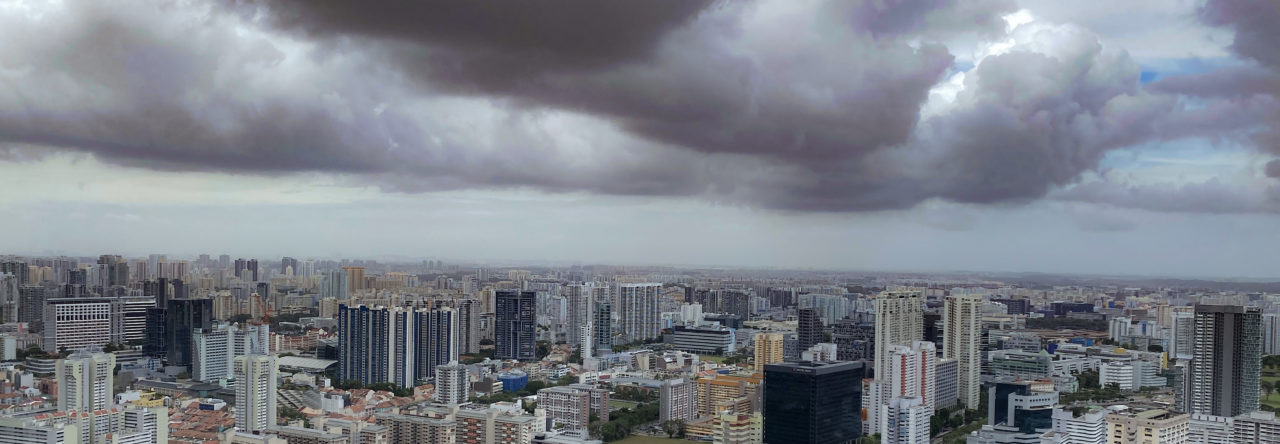
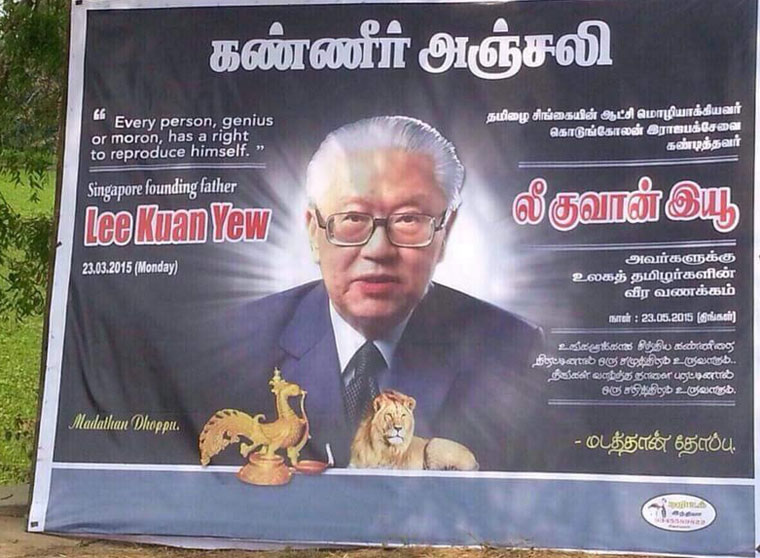

Unlike-Lee admirers around the world may be missing significant details.
In an amusing case of mistaken identity, a banner honouring Lee Kuan Yew has appeared in India, bearing a photo of another Singaporean elder statesman, President Tony Tan. Both are white-haired ethnic Chinese males, but Tan, as you have may noted from Channel NewsAsia’s coverage of Lee’s funeral today, is rather more alive.
The picture has been making the rounds on social media in Singapore, bringing smiles to an otherwise sombre day. It serves as a useful reality check for Singaporeans, that although Lee has been lauded by world leaders as a 20th century giant, not everyone can recognise him from Tom, Dick or Tony.
Some other cases of mistaken identity are less trivial. It’s nothing new. For at least a couple of decades, he has been all things to all men who aspire to a certain kind of leadership. They see in him a model, a kind of proof-of-concept that they can point to when defending their own missions and methods. Leader X is Country A’s Lee Kuan Yew. How often have you heard that line.
As a Singaporean born in the year of the republic’s independence, I’ve benefited from Lee’s global brand, most tangibly in the fact that my red passport travels extremely well. But the way that brand is sometimes used is cringeworthy.
Most of the parallels that foreign politicians and their acolytes draw with Lee Kuan Yew are selective and self-serving. His name is evoked by anyone who wants to apply less-than-democratic means in the name of strong, decisive leadership in order to achieve high economic growth. But there was a lot more to the man and his formula for success.
The most obvious was the zero tolerance of corruption that he embodied and instituted in the Singapore system. That is probably a chapter in his bestselling memoirs that admirers like former Thai prime minister Thaksin Shinawatra skipped. Similarly, fans of Indonesia’s late president Suharto who cite his friendship with Lee conveniently ignore the fact that Suharto topped the world league table of corrupt leaders, according to the same organisation that routinely names Singapore as the cleanest in Asia.
Less noticed is the fact that Lee, while loudly dismissive of the liberal brand of democracy, never deviated from electoral authoritarianism – the belief that regular multi-party elections are ultimately the only way for a government to win legitimacy, and are not bad at keeping a dominant party on its toes. Of course, he did his best to insulate his government from distractions like short-term public opinion, an adversarial press and protest movements; he also treated the opposition unfairly, to put it mildly.
But, to this day, elections in Singapore remain competitive enough and credible enough to make democracy “the only game in town”, as political scientists would put it. As a result, opponents of the regime plot election strategy, not extra-parliamentary struggle; and Singaporeans accept the government’s authority as legitimate, even if they disagree with its policies. The thousands of Chinese officials who pass through Singapore to learn the Lee model may think this lesson can’t apply to the People’s Republic, but shouldn’t overlook how important it has been to Singapore’s success.
Back to India. When its government decided to fly the tricolour at half-mast today, I wonder which Lee they were honouring. I hope – but I doubt – that it was the leader who stood resolutely against sectarian politics and majority domination. Among all his core principles, this is the one least talked about abroad. Yet, to minorities like me – and, thankfully, most members of the majority race as well – this may be the single most precious aspect of the legacy.
Not that he got everything right. Older Indian Singaporeans still bristle at the way he labelled us as “fractious and contentious”. The stereotype might not have been off the mark (note Amartya Sen’s Argumentative Indian thesis), but if only he had seen it as a positive contribution to Singapore’s national culture rather than a weakness. Similarly, his open suspicion of Muslim Singaporeans’ growing religiosity was hurtful. Some of such straight-talking about race and religion could come back to haunt Singapore, should future bigots exploit his words to justify their prejudices.
But minorities never needed to doubt this: Lee was an unshakeable bulwark against majoritarian tendencies that could have easily overwhelmed Singapore. Malay/Muslims make up only 15% and Indians 7% of the population. For decades, the risk of a Chinese chauvinist party playing the race/language card posed the single biggest threat to PAP dominance. This fact is lost on most of the Western press, who self-aggrandisingly like to believe that they were Lee’s bête noire. They were more like sparring partners, compared with champions of the Chinese-speaking ground, who were the main victims of both detentions without trial as well as flagrant censorship.
Lee went to the extent of amending the republic’s Constitution to stop any party from sweeping into power without minority support. For most Parliamentary seats, candidates are forced to contest as small teams that must include minorities. Thus, no Chinese party could do in Singapore what the BJP did in India last year – come to power without a single MP from the country’s largest minority group.
Thankfully, Lee and his comrades were influenced by an older Indian tradition, the Nehruvian secular ideal that accommodated minorities – the same tradition that the BJP and the larger Hindutva movement is bent on dismantling.
Singapore should not presume that it can serve as a model for any other country, least of all India. The world’s largest democracy is 200 times larger than the city state that Lee ran, and its challenges are profoundly more complex.
But if foreigners do choose to honour Lee Kuan Yew, they shouldn’t fall into the mistaken-identity trap. Yes, he was a firm leader who stretched the limits of democratic government to breaking point in order to get things done.
But a leader who makes minorities feel unwanted, insecure and fearful?
That’s not a face that Singaporeans recognise.

Looking beyond the liberal/conservative divide
Some will see it as a victory for a vocal minority of liberals. Others will declare it a conservative triumph. Perhaps, though, it was never about where the government landed on the left-right spectrum. What was really at stake were the principles by which a multi-cultural nation makes decisions that will inevitably offend one community or another.
This specific controversy was over three children’s books meant to teach kids about non-conventional families. The National Library Board’s professional librarians had earlier decided they were suitable for acquisition, but some parents complained that the books were too soft on homosexuality. As a result, the books were to be discarded. Following a public outcry, the government intervened, in time to save two books from pulping. They will not be returned to the children’s shelves, but will be made available in the adult section.
Compared with the earlier decision, this is a passable compromise. It concedes to the conservatives that the books should not be freely available to all children regardless of the moral objections of some of their parents. At the same time, it does not permit these parents to dictate standards for all library users: adults interested in teaching their own children to be more broad-minded about what constitutes a loving family can still borrow the books.
What was striking about the earlier decision was not so much that it did not conform to liberal standards (nothing new there), but that it deviated from the government’s own principles. For more than 20 years, it has been official policy to avoid censorship when classification would do. A totally laissez faire approach to public morals would fall short of the fundamental societal obligation to protect the young; it would risk treating children like adults. At the other extreme, a crude censorship approach treats adults like children, denying them choices that they are entitled to.
In contrast, classification maximises choice for consenting adults while protecting the vulnerable. NLB’s original response to the conservatives’ complaints was inconsistent with this rational, well-established approach. The latest decision simply brings the practice more in line with the principle. Instituting a proper, transparent review process would have to be the next step. Expert judgments by professional librarians need to be shielded from shadowy complainants who are not prepared to come out to justify their positions publicly.
Even more disquieting was the fact that the decision to pulp was part of a wider pattern, of deciding cultural policy based on how offended people are. It is dangerous for the government of a multi-ethnic country to resolve disputes this way, even if they side with the majority. Once the referee signals that he will side with those who cry the loudest, some players will start outperforming the most talented World Cup actors.
In football, at least, an eagle-eyed referee and slow-motion HD replays can discover the truth: was it a real foul or did he dive? When it comes to religion and morality, however, it is all subjective. No amount of rational theological forensics can establish whether a believer’s outrage is justified. Governments that agree to play this game end up having to take community leaders’ word for it, that they are suffering intolerable indignity.
Around the world, religious leaders use this inherent uncertainty to their own political advantage. Claiming to be offended and then declaring battle against the real or imagined source of that offence is one of the easiest ways to galvanise your followers; gain a higher profile than your competitors; put opponents on the defensive; and play the state like a puppet. It happens in Malaysia; it can happen here.
Indeed, as the most religiously diverse country in the world, Singapore is particularly prone to this risk. There is no limit to the offence that the intolerant can choose to take from what other communities do. Proselytisation by Christians and polygamy among Muslims are just two examples of practices that some consider consistent with their faiths – but that others find upsetting. Thus, restrictions based on the capacity to offend won’t just hurt secular liberals; it will also backfire on the most devout.
In most countries, like Malaysia, the state simply sides with the majority community (it’s wrong, but at least it’s unambiguous). Here, where there is no religious majority, the state will find itself pushed this way and that. And the ultimate result will be the conclusive unwinding of Singaporean experiment in multi-racial, multi-religious harmony.
The only responsible approach for a society like Singapore is for the state to adopt a strong bias for tolerance, and suppress nothing other than the most extreme of speech. Adult Singaporeans need to be educated to look after their own feelings.
After decades of enjoying the dubious privilege of turning to a nanny state whenever one feels offended, many Singaporeans will find this a difficult adjustment. Indeed, by changing tack, the government may lose more votes than it wins. But it is the only viable strategy for a crowded city-state whose greatest asset, as well as its greatest challenge, will always be its cultural diversity.
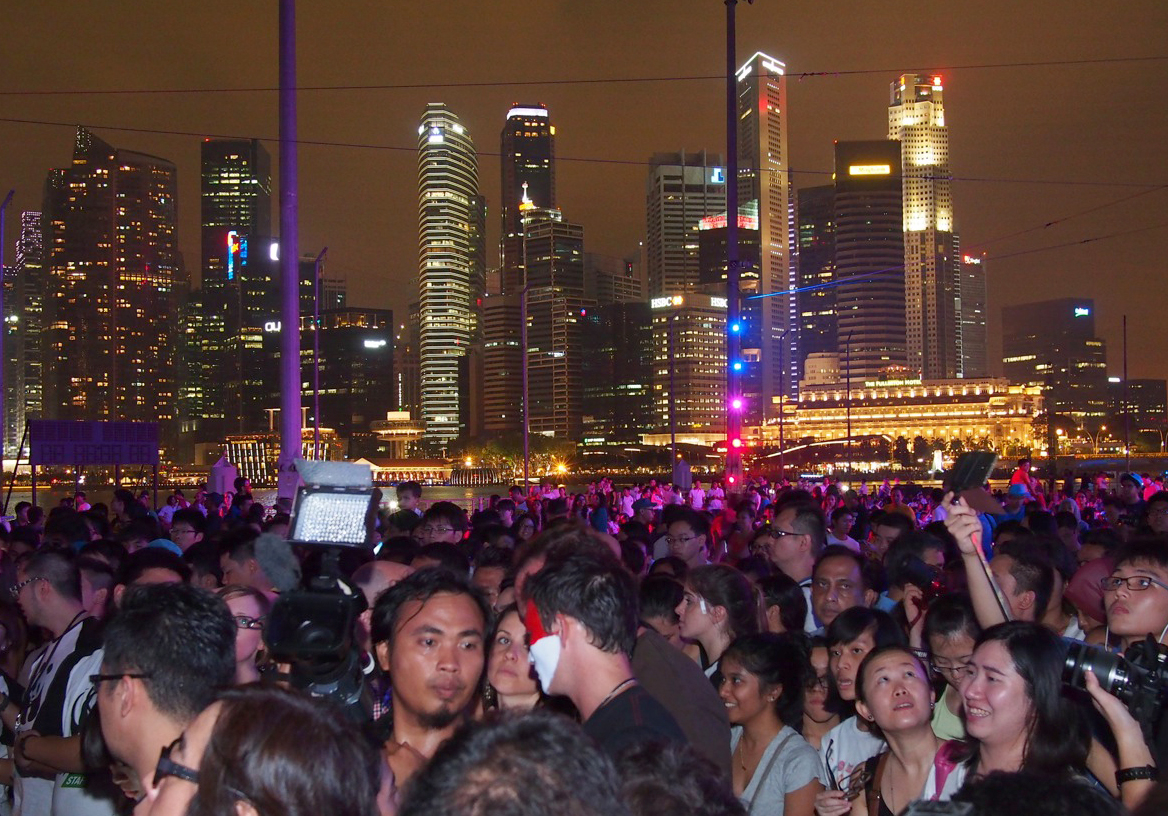
Let’s stop judging activism in PAP-centric terms
Last month, thousands gathered at the floating stage in Marina Bay for Singapore’s observance of Earth Hour, dubbed the world’s largest mass participation event ever. An offshoot of the nature conservation group WWF, Earth Hour is now headquartered in Singapore, thanks in part to government incentives to turn the country into a hub for international nonprofits. The event was graced by a senior Singapore diplomat and supported by the private sector, including media outlets drawn by the star power of the Amazing Spider-Man cast.
The same month, a group called Maruah marked the International Day for the Elimination of Racial Discrimination and International Women’s Day with important statements on how Singapore could make further improvements in addressing inequality. Maruah is Singapore’s human rights NGO. Its causes are not populist. As if it was not difficult enough for Maruah’s campaigns to gain public acceptance, the government has placed extra hurdles before it. Its fundraising is restricted under the Political Donations Act, and it recently had trouble booking even a dosai restaurant for an event, let alone the iconic Float@Marina.
Earth Hour and Maruah represent two faces of activism in Singapore. The people behind them are passionately devoted to making the world better by pushing for changes in values that will ultimately translate into more enlightened policy. But official receptivity towards them could not be more different.
Of course, even liberal democracies do not treat all kinds of activism equally. At one end of the spectrum are causes that enjoy state support. A government may actively facilitate citizen initiatives aligned with its own agenda (e.g. the Canadian government provides subsidies for events promoting intercultural and interfaith understanding, as part of its multiculturalism mission).
At the other extreme, democracies prohibit certain methods of activism. Activists who literally throw stones, destroy property or hack into websites face arrest, no matter how noble their causes. It is also reasonable for authorities to impose restrictions on where, when and how boisterous demonstrations can be conducted. Sometimes, activists’ goals are seen as incompatible with protecting others’ dignity and basic rights and dignity (e.g. Germany bans National Socialism because of its genocidal track record).
Then, there is the large in-between category of activism that is neither positively supported by the state nor treated as illegal. It faces the mixed blessing of benign neglect: the lack of official support means that this zone is often the most creative and innovative.
Singapore approach
Activism in Singapore deviates from these democratic norms in two respects. First, some activism is treated as illegal even though it poses no threat to public order and does not violate the rights of other citizens. One example of this is the banning of video interviews of former detainees, produced in order to present their versions of the Singapore story. The only interest served by such legal action is to protect the government’s ideological control, which is not a legitimate reason for censorship in a democratic society.
Second, the large middle category of merely tolerated activism – permitted but not supported – is further subdivided, with some forced to face more official restrictions and obstacles than others. Unwanted special treatment could come in the form of extra layers of regulation, difficulties in securing venues for events, and blacklisting of volunteers when they apply for public sector jobs.
Such discrimination might be acceptable if the targets were bona fide threats to national security. Often, however, they are at worst inconvenient to government, forcing officials to spend more time and effort defending their policies. Official hypersensitivity to dissent was illustrated recently by remarks made by a senior civil servant to the Straits Times. Warning that policy-making should not be hijacked by what he described by “a very loud and noisy minority”, he cited the example of the campaign against the death penalty. These activists were certainly passionate and outspoken, but they barely registered on the political decibel scale. They could seem “loud and noisy” only to ears quite unaccustomed to hearing dissonant voices.
Where the government draws the line between permitted and restricted activity can be inconsistent. Take its oft-stated position that Singapore politics is a matter for Singaporeans, and that groups that may influence public affairs should be banned from receiving foreign funding. This argument has been used to restrict the growth of Maruah as well as citizen media like The Online Citizen and the Independent. It is also used to prevent some event organisers from bringing in foreign speakers.
Yet, there are much larger and more influential organisations that face no such restrictions. Certain religious groups, for example, have made their presence felt in national debates on contentious issues such as sexuality. The rise of intolerant brands of Christianity and Islam in Singapore can be traced to material and doctrinal support from the United States and Saudi Arabia respectively. Similarly, our cultural and entertainment spaces have given virtually free rein to foreign influences, in ways that have spread consumerist values and the objectification of women. Thus, powerful right-wing religious as well as commercial forces have been allowed untrammeled access to the public mind, while tiny groups of Singaporeans who want to counter these trends by advocating secular, non-commercial, human-rights values face official obstruction. Such discrimination happens because of the arbitrary manner in which some activities are labeled “political”, bearing little relation to what actually does affect political values.
Discriminatory treatment of activists is shored up with highly subjective language. For example, citizen participation is encouraged – but it should not get “political”. We are routinely told that Singapore welcomes criticism – as long as it is “constructive”. We want ideas that are out of the box – but not “adversarial”. Singaporeans should serve with passion, but without “agendas”. And so on. Such distinctions are in the eyes of the beholder, and in Singapore the only beholder that counts is the government.
Singaporeans have internalised these ideological categories. Critics deploy the same language to plead that their own comments should not be mistaken as destructive or adversarial. For example, after the website Breakfast Network chose to shut down rather than comply with the government’s new registration requirements, its founder objected to a report stating that it “refused” to register, saying that “declined” was a better word because “refused… makes us sound like rebels”. Similarly, civil society groups bend over backwards to avoid the accusation that they are “political”. Such sensitivity to semantics is a learnt response to the government’s “OB” markers, but it also legitimises and perpetuates those same divisions.
Activists at the other end of the political spectrum can be equally susceptible to these mental divides. They display a kind of reverse snobbery, pooh-poohing activists who are not as anti-government as they are. No doubt, certain causes require more political courage than others – with, say, disability rights lying at the less politically-contentious end of the spectrum, civil and political rights at the opposite extreme, and nature and heritage conservation somewhere in the middle. Surely, however, the respect that we show one another within civil society should depend on one’s sincerity, knowledge, wisdom, selflessness and hard work; I am not sure why being anti-government should be the only badge of honour.
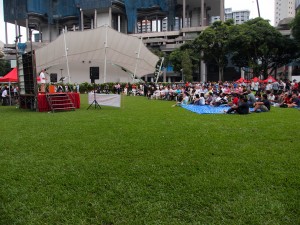
Anti-ISA event at Hong Lim Park.
Like its critics, the government should stop judging activism in PAP-centric terms. Yes, activism needs to be regulated. But, the test should not be how much a cause deviates from official positions. Yes, government should protect public order and the rights of others. But, there is no need to protect Singaporeans – least of all public servants – from discomfiting ideas.
We are about to celebrate 50 years as an independent, citizen-governed state; recently, we have been congratulating ourselves on the quality of an education system that is producing young people who are apparently world beaters in problem-solving and coping with complexity. Policies that do not trust citizens to make their own judgments about which activists to side with make a mockery of these milestones.
– This article was prepared for a panel discussion, “The Turning Tide: The State of Activism in Singapore”, held on 17 May 2014 at the Lee Kuan Yew School of Public Policy, NUS, as part of its Angsana Evening series.
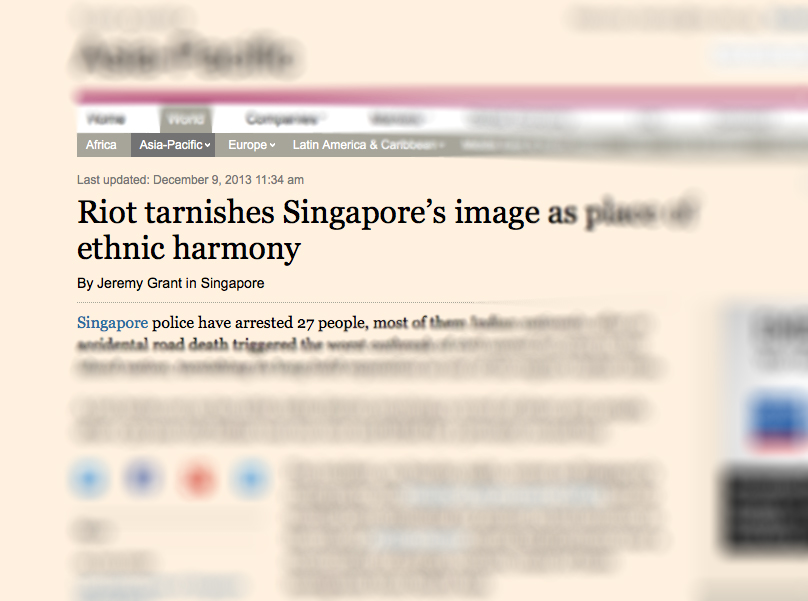
Racial riot? Really?
London’s Financial Times headlined its online story “Riot tarnishes Singapore’s image as place of ethnic harmony”. A Forbes Asia blog claimed that the incident “highlights ongoing tensions between the ethnic groups that call Singapore home”. Al Jazeera did not go that far, but hinted at it by presenting data on Singapore’s ethnic mix. And a reporter with a leading global news broadcaster prefaced her request for an interview with me by referring to “racial riots”.
The instinct of some foreign media to frame the Little India Riot as race-related may reveal more about their own prejudices than about the reality of what happened on Sunday evening. It is of course true that ethnic minorities here occasionally face subtle and not-so-subtle discrimination, but it would be a stretch to assume that the riot had much to do with that. The existence of racism doesn’t mean that the racial lens is always the right one through which to view events. If the riot reveals any deeper divisions – and most reasonable Singaporeans know that it does – those divisions are probably ones of nationality and class, not race. Not that this would be a less serious social ill; but it is important to get the diagnosis right if we are to treat it effectively.
A racial explanation of the riot implies that if it had been a crowd of mainland Chinese construction workers who saw one of their countrymen killed by a bus driven by a Chinese Singaporean, and if Chinese Singaporean police and civil defence personnel had arrived at the scene, the absence of the race factor from the equation would have resulted in a peaceful resolution of the situation. One just needs to consider the daily incidence of uprisings among Chinese workers in China to be disabused of such a fiction.
But the misunderstanding is not surprising. After all, if an editor on the other side of the world receives news from majority-Chinese Singapore of a riot breaking out in “Little India” involving only South Asians – what else would he think?
It takes local knowledge to understand that Little India is not an ethnic ghetto in the mould of those in Europe and the United States where riots have broken out in recent decades. Most Indians don’t live there, but (along with other diversity-loving Singaporeans) love visiting it as a cultural haven. It is the place to go for the best Indian food, clothing, groceries and goldsmiths, and its higher than usual concentration of Hindu temples.
Urban geography, not race, explains why the riot was an all-South-Asian affair. On Sundays, Singapore’s hundreds of thousands of migrant workers gravitate to particular neighbourhoods that have evolved organically into gathering spots for the proletariat from different parts of Asia. If a similar incident had erupted in the Beach Road area, it would have been an all-Thai affair. Around Peninsula Plaza, it would have been all-Myanmar. And if a migrant worker riot ever broke out around Lucky Plaza on Orchard Road, you can bet that it would be a Filipina expression of People Power.
Fortunately, Financial Times and company were the exception. Most foreign media reports correctly framed the riot as a by-product of the country’s dependence on low-cost foreign labour and a possible symptom of their discontent. These included international news organisations (Reuters , AFP , AP, the BBC and CNBC) and – critically for Singapore’s relations with India – Indian media such as the Hindu and the Times of India.
A Wall Street Journal blog – written by two local staffers – stated:
“The riot has sparked concerns of festering unrest amid the large foreign workforce, numbering about 1.3 million as of June, in this island state of 5.3 million people. In recent years, some foreign laborers—particularly low-pay unskilled workers in construction—have resorted to protests against alleged exploitation by employers, including a rare and illegal strike last year by about 170 public-bus drivers hired from China.”
The writers understood that the size of the migrant worker population was more relevant to the story than Singapore’s ethnic composition. And, they recognised that the most closely related precedent was not the race riots of the 1960s but the Chinese bus drivers’ strike – which of course destroys the theory that such incidents have much to do with race.
If anything, Singaporeans’ determination to preserve the nation’s multi-ethnic identity is shining through. Ethnic Chinese Singaporean Adrianna Tan, for example, plans to organise a monthly walking tour of Little India to share her love for the neighbourhood. I know some journalists who might find the experience educational.
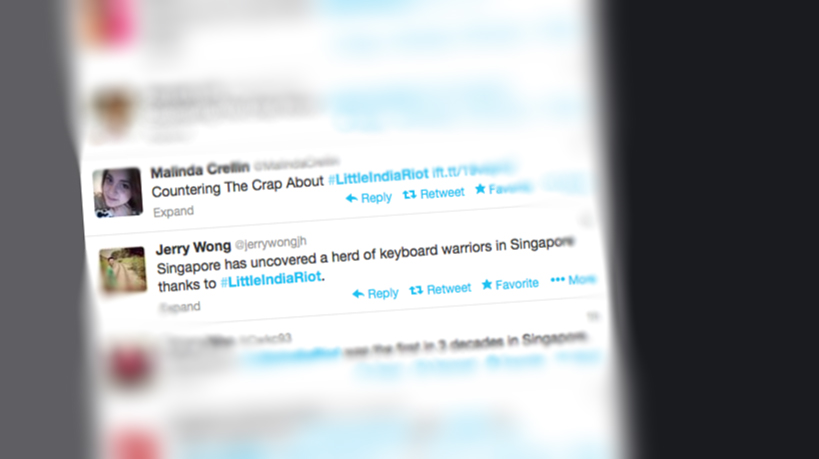
Singaporeans are torn between seeking retribution and wanting to understand.
Whenever a society is beset by mob violence, opinion is almost always divided between demands for uncompromising punishment, and calls for empathy and self-critique. It should be no surprise that our own Little India Riot has provoked a similar spectrum of responses.
The tension between retribution and compassion, between blaming the outlaw and blaming the system that made him an outcast, has been investigated in the world’s greatest literature, its major religions, and its systems of justice – but never conclusively resolved. So, as passionately as we hold one or another point of view, nobody should expect our debate to be settled by a soundbyte, a tweet or Facebook post.
What we can safely say is that neither extreme works. To excuse all wrong-doing as the product of systemic injustice is to invite chaos and negate humans’ capacity to use their conscience. For the authorities to take that view would be shirk the number one job of any state, which is to maintain the orderly conditions for peaceful social life.
However, to respond to criminality only with force – and, when so many individuals are involved, never get round to asking “why?” – would be bad policing, at the very least. The riot seemed like an isolated event, but it would be irresponsible not to look deeper. Uncovering contributory factors and addressing them could avert the next such event.
Mustering empathy for the perpetrators will be difficult if we buy into the comforting illusion that there is only one “Singapore” with one set of norms – the ones we are familiar with. In that Singapore, our Singapore, we take for granted that we can count on those in authority to help us in a life-threatening emergency. But, within our borders are separate Singapores for foreign workers. One of the documented dysfunctions of these other Singapores is the existence of rogue employers who do not treat injured workers in a particularly humane way. Might this warp the judgment of workers who see a comrade fatally injured? This is just one of questions I hope will be answered through sober, fact-based analysis.
The debate that is commencing is an important one; it deserves to be conducted in a healthy fashion. Reliable information is vital. It was reassuring to see that, at the height of the emergency, the Police understood the importance of effective crisis communication, using Twitter and Facebook to give timely updates. Let’s not underestimate how challenging that must have been – they had their hands full trying to deliver a decisive yet measured response (evident from the fact that they sustained more casualties than the rioters). The effort paid off. The information the Police provided ensured that unfounded rumours did not take root for long enough to do any damage.
Equally positive was the role played by many netizens to urge calm, and to blow the offside whistle against irresponsible and tasteless speech.
In the weeks that follow, one hopes that this commitment to transparent and responsible communication is maintained both by official sources and ordinary citizens. It cannot be anything other than a controversial and heated debate. Already, the cheap point-scoring has commenced, linking the riot to various pet peeves. Differences in viewpoints are inevitable and necessary; but whether they end up being divisive is up to us.
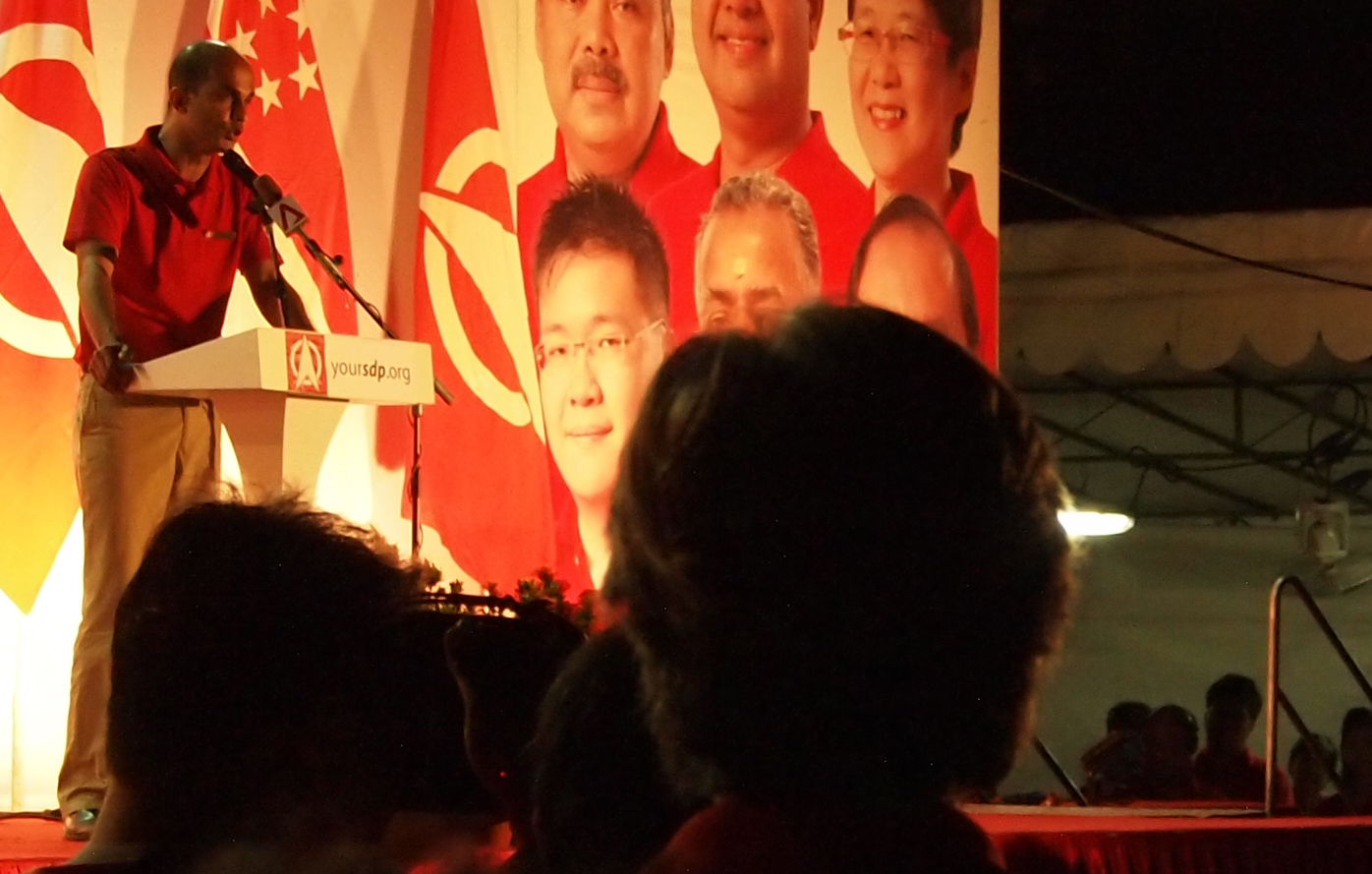
Not all worthy causes are vote-winners; that’s why politics shouldn’t be left to political parties.
August 28, the day that Vincent Wijeysingha announced his resignation from the Singapore Democratic Party to devote himself to the struggle for civil liberties, happened to mark the 50th anniversary of Martin Luther King Jr.’s “I Have A Dream” speech, addressed to the largest civil rights demonstration in history. Whether this was pure happenstance, a conscious nod to history, or ordained by zodiacal forces – I have no idea. In any case, the coincidence does inspire reflection on the role of such activism in modern politics.
In normal countries, it is unremarkable to see individuals pass back and forth through the revolving door between electoral politics and civil society activism. Several politicians come from civil society in the first place and quite naturally return to their roots. Ralph Nader continues to work as a consumer rights and environmental activist in between US presidential bids. In Malaysia, many leading lights straddle party politics and civil society. Irene Fernandez, for example, is a council member of the opposition PKR, but is better known as a human rights defender and the head of advocacy group Tenaganita.
In Singapore, few politicians come from civil society, and the little traffic there is tends to be one-way. PAP ideology prefers political beings to go through a life cycle with distinct stages, culminating in elected office. It’s like metamorphosis. A caterpillar is allowed to transform into a butterfly, but while it’s just a caterpillar, it should know its place, keep its head down, and never act as if it has the right to flaunt its colours or to fly – that’s butterfly territory.
Over the decades, the government has reinforced this order by restricting societies’ establishment and operation. It also sticks on troublesome groups and individuals such labels as “political”, “agenda” and “partisan” (pap for short; you could say that big PAP is not fond of little pap’s), which basically means that they will be treated as akin to national security threats.
The logic of these labels is questionable: after all, any intervention in the public sphere is at some level “political”. And when does a passionate interest in issues (something that the government says it wants to encourage through initiatives like the proposed Youth Corps) become an “agenda” deserving of its proverbial knuckle-duster treatment? As for partisanship, not even a constitution that disallows it from affiliating itself with any political party was able to save the human rights group Maruah from being subject to the Political Donations Act, which was ostensibly meant to keep money out of the electoral system.
But so overpowering are these labels that most of their targets usually scramble to live them down, rather than trying to challenge the assumptions behind them. Most civil society groups tend to err on the side of caution rather than risk being called “political”. And the SDP took pains to stress that it did not have a gay “agenda”, whatever that means.
Twenty years ago, a bunch of political kaypohs (including this one) got together to form a group called the Roundtable. It challenged the government’s position that individuals with a political agenda should only work through political parties. We felt differently: that it was the right and responsibility of citizens to be engaged in our nation’s civic life, and that non-partisan engagement was both necessary and legitimate.
The Roundtable managed to get registered as a society and operated for a few years before it ran out of steam. It would be nice to believe that the group pushed back the “OB” markers, staking out a bit more space for civil society.
However, the ruling party’s ideology still has a strong hold. To see how deeply entrenched is the PAP’s life-cycle view of political participation – that individuals who are serious about their causes should come out from civil society, join political parties and not turn back – look no further than some of the comments that greeted Wijeysingha’s announcement. “If you want change, join a political party, rally people to your cause, get into Parliament – and change things,” went one.
Clearly, the significance of that day’s worldwide remembrance of Martin Luther King and the civil rights movement was lost on such commentators.
The simple reason why civil society activism is a vital complement to electoral politics in a democratic society is that not every worthy cause is a vote winner. Often, it takes time for the majority to get on board. Sometimes, they never do. Government leaders then have to decide whether to do the right thing even though most voters remain nonplussed or outright opposed to change.
In proportional-representation systems, parties can win seats despite championing minority causes. Green parties in Europe are a case in point. But in a first-past-the-post, winner-take-all electoral system like ours, it is unlikely that any political party will push issues supported by only a minority of voters. Invariably, civil society activism is needed to give governments a nudge.
As necessary as electoral democracy is for a country’s well-being, it is not sufficient. Consider some of the principles that today’s Singaporeans benefit from. The right of women to vote; or of Asians to govern their own societies. The moral unacceptability of putting children to work instead going to school; or of enslaving adults.
We now take these for granted as fairly basic requirements of a civilised society. Yet, these principles did not always enjoy such common-sense status. In an earlier time in many societies, even many victims who stood to benefit from enlarged rights and liberties did not consider their lot as an abomination but as the natural order of things. Changing people’s attitudes and lawmakers’ calculations took decades of consciousness-raising by activists, writers and other people of conscience who were focussed on winning the favour of history, not conforming with the flavour of the times.
Let’s not kid ourselves that we – in Singapore or anywhere else – have already achieved a state of civilisational perfection. Future generations will be contemptuous of some of today’s social mores and public policies, just as we look down on our forebears for practising or condoning what we in a more enlightened age know to be wrong. It would be hubris to expect otherwise. The only uncertainty is what exactly history will judge to be the greatest injustices of our time. For those who would like to know sooner than later, history shows that the clues are more likely to come from civil society than from political parties.
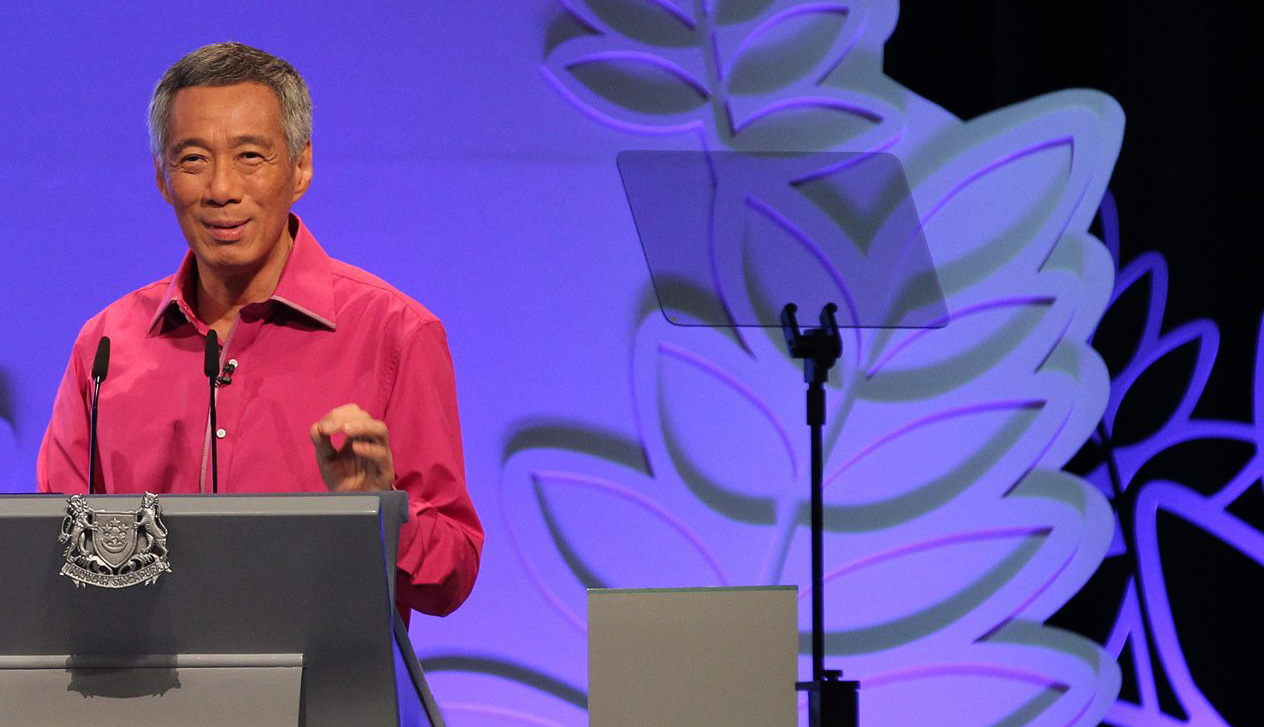
The Prime Minister’s National Day Rally Speech avoids political controversy.
This evening’s National Day Rally Speech was probably Lee Hsien Loong’s best ever, because he played to his government’s strengths – and sidestepped its main weakness.
Compared with most states, the PAP government has traditionally scored an A* in tinkering with policies to stay responsive to the needs of the majority. It has found it harder to excel in this subject lately, perhaps because the local population and the global economy have changed the syllabus. Nevertheless, the PM showcased the PAP’s technocratic talents, trying to tackle key concerns over housing, healthcare and schooling.
Importantly, he recognised that with trust in the PAP’s capacity to deliver at all-time low, a battery of acronyms old and new would not be enough to win the public over. Neither would it suffice to recite past accomplishments, for that would signal complacency on the PAP’s part. Instead, he punctuated the announcements with some simple and powerful words: “I promise,” he said at the start; and “Don’t worry” he declared more than once. These assurances might have fallen flat if they had come from some of his colleagues, but many Singaporeans, even among those who feel his government has lost its way, would concede that his own dedication to his job is hard to fault. When speaking about ordinary Singaporeans who overcame hardships, he had to fight back tears. It’s not the first time. Lee’s eyes may light up when he talks about cutting-edge technology, but they reveal the most emotion when he’s reminded of the lives that can be improved when grassroots grit and sensitive policies meet.
The second T-score-boosting skill of the PAP has been its breathtaking ability to dream big. And it hardly gets bigger than the plans for Changi Airport, Paya Lebar Air Base, the new port at Tuas and the old one at Tanjong Pagar. Of course, when full details are revealed, there will probably be plenty to quibble over. But, in contrast to countries where megaprojects are more discussed than delivered, I don’t think anyone doubts that this government will get the job done.
It was a smart choice to focus on these particular infrastructural projects in the Rally speech. Many Singaporeans are uneasy about their country becoming the region’s playground – which is what the integrated resorts are making it – but few question the ambition to remain Asia’s air and sea transport hub, which is a far deeper, existential part of Singapore’s identity.
If his speech goes down well, it will also be because he didn’t add to the mix the one thing that usually gets stuck in the craw. He made passing reference to the need to “get the politics right” – a line that has featured in most of his major speeches in recent years. But, this time, he’d clearly decided against elaborating on the point. He paid the opposition and other online critics the ultimate insult of ignoring them. Perhaps he decided that, since his government is not ready to cede any ideological ground, it is pointless to attract unnecessary attention to that fact. The PAP may also have arrived at the conclusion that some sections of the population just cannot be won over.
The question is whether the non-inclusion of political reform in the NDR agenda is a sign of things to come, or, rather, not to come. Some of us feel strongly that the Singapore project is incomplete as long as democratic institutions and practices remain underdeveloped. The PAP’s 2011 electoral setback seemed a timely moment to for the ruling party to reconsider its political blueprint. However, there was always going to be an alternative scenario: the PAP would bypass the need for structural political change and focus instead on correcting its social and economic policies to win back the middle ground. Economist and former civil servant Donald Low was among those who saw this as the most likely, though sub-optimal, of the PAP’s possible responses.
It is, after all, the only way it knows how to govern. Singaporeans’ age-old social compact with the PAP was “give me liberty or give me wealth” – as former Straits Times columnist and academic Russell Heng nailed it more than 20 years ago. Many argue that a new generation of Singaporeans cannot be so easily bought – or that this is no longer a tenable trade-off, since wealth creation in the new economy will depend increasingly on more freedom of thought and expression. However, it is an open question whether this theory that authoritarianism is unsustainable was ever anything other than wishful thinking on the part of liberals.
Judging by PM Lee’s speech, it certainly doesn’t look as if the PAP believes that its politics requires a new way forward.
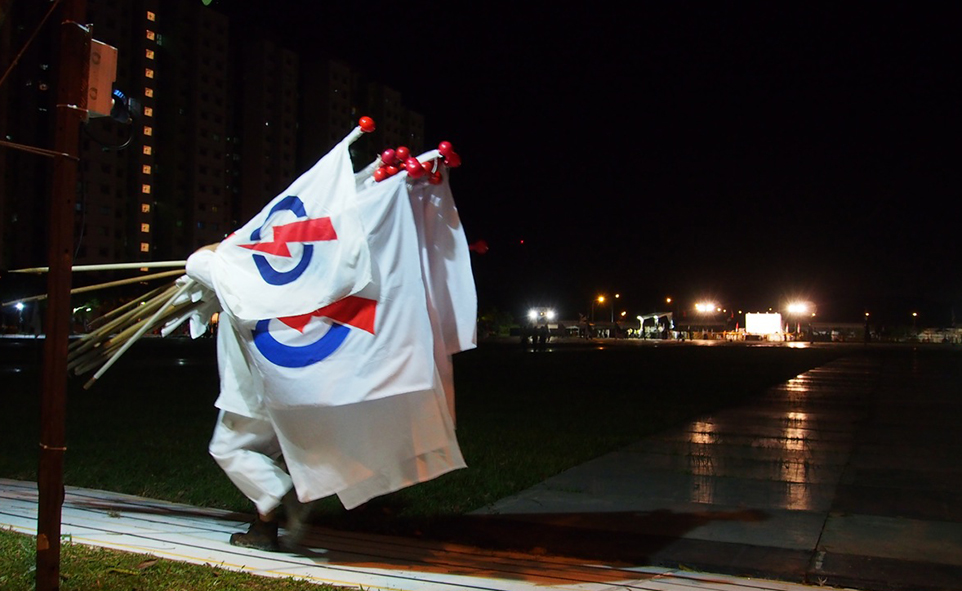
What the Punggol East result says and doesn’t say about the future.
Predictably, the Workers’ Party’s decisive victory in Punggol East has prompted speculation about whether this spells doom for the People’s Action Party in the 2015/16 General Election.
Such thoughts – wishful or alarmist, depending on your point of view – are unrealistic. First, GRCs do not behave like single seats. It is much harder to produce big swings in mega-constituencies than in a ward like Punggol East – a fact overlooked by Alex Au in his thought experiment on the effect of a national 10-point swing.
More importantly, such extrapolation overlooks one of the main characteristics that the Singapore electorate has revealed about itself in election after election. It wants opposition – but not just any opposition. Parties and pundits have consistently underestimated how discerning the electorate will be. In the run-up to last weekend’s poll, we wondered if Kenneth Jeyaretnam and Desmond Lim would split the opposition vote or confound swing voters so much that they would eventually stick with the PAP. In the end, the lack of opposition unity didn’t matter because voters made up for it with their singular focus on the most serious opposition team.
We can expect the number of high-quality opposition candidates to grow dramatically by the next GE, but we still won’t see them blanketing the whole island. For every constituency with a Lee Li Lian or Chen Show Mao taking on the PAP, there will be one or two others where the opposition candidates are just so-so or just loco. These individuals are not going to get the kind of swing that the WP enjoyed over the weekend.
A scenario that is more sober but still gamechanging is a major increase in opposition representation, but with the PAP still firmly in power. Arguably, this is the endpoint that Singapore’s middle ground has in mind. The WP leadership seems to think so, too. Its response to its latest victory dismissed talk of replacing the PAP, positioning itself as an effective check to keep the ruling party on its toes.
The PAP has tried to argue that it already has enough incentive to perform – primarily from its innate desire to serve – and that there are enough alternative voices in Parliament, thanks not only to the elected MPs but also NCMPs and NMPs.
If Punggol East voters speak for the country, it’s clear that Singaporeans don’t quite agree with the PAP that the right equilibrium has already been reached. Until an acceptable balance is achieved, we’ll continue to see the electorate practise a kind of affirmative action in favour of the opposition, with its candidates constantly given generous benefit of the doubt while PAP candidates are punished for verbal slips, or even just for their facial expressions (the “arrogant smirk” that Yawning Bread detected on Koh Poo Koon’s face might have been read as cool confidence, and the “fixed plastic smile” as understandable nervousness in front of the cameras, had Koh been wearing the Hammer badge).
What then is the “right” number of opposition MPs? My guess is that it is much higher than the current 8 percent of Parliamentary seats, but maybe not as high as 40 percent – the proportion of Singaporeans who voted for the opposition in the last election. As the number of opposition MPs rises beyond 20-30, you’ll see more voters wary of a “freak” result ousting the PAP entirely, and becoming more conservative. You could also see the PAP reforming itself dramatically, giving voters less reason to reject its candidates.
If the opposition grows to occupy more than 40 percent of the House, it would be because of a major slide in the performance of the PAP, which is of course not beyond the realm of possibility.
Even if the opposition collectively claims more than half of the seats, this may not spell the end of the PAP in government. It depends on whether the opposition parties are willing to form a coalition. As the Punggol East campaign showed, nobody should assume that just because opposition parties are repelled by the PAP, they are attracted to one another.
I don’t think it’s preordained that if the WP had to choose between the SDP and the PAP in a hung Parliament, it will opt for SDP. It could instead enter a grand coalition with the men in white, in return for a few Cabinet positions and legislative reforms, say.
In the interest of full disclosure, I should at this point declare that I am one of those who totally misread the Punggol East by-election, believing from start to end that the PAP would retain the seat. For more reliable predictions of future election outcomes, visit your local bookie.
But even if the eventual numbers are anyone’s guess, it is possible to make fairly firm non-quantitative predictions about how electoral politics will evolve over the next few years. Some of the dynamics were already apparent after the GE and last year’s Hougang by-election (see my earlier articles here and here). In addition, there are a couple of other developments to look out for.
First, we can expect to see the Workers’ Party attract several heavyweight candidates – including members of the establishment with some stature. This is a no-brainer, because the signs were already there in 2011. The WP’s most significant gain from Punggol East may not be the one additional seat, but the several fence-sitting, high-calibre potential candidates whose last remaining doubts about the joining the party will now evaporate.
Second, we will see the PAP torn between tactics. In the battle for Aljunied GRC, the PAP offered multi-million-dollar upgrading inducements, tried to tar Chen Show Mao as a foreigner and threatened voters that they would regret and repent if they kicked out the PAP. Voters kicked out the PAP, giving the WP 54.7 percent.
In the battle for Punggol East, the PAP fought an unusually clean campaign, with no personal attacks, bribes or threats. And? Voters kicked out the PAP, giving the WP 54.5 percent. Two different tactics, same result. Unfortunately, there goes the theory that if the PAP was just more pleasant, voters would like it more.
While the PAP is sure that its broad policy directions are in Singaporeans’ best long-term interests and that they will eventually realise it, you can hardly blame the party if it feels at a loss over what political tactics will keep it in power. Expect an internal debate between hardliners and moderates (though, given the party’s strong cohesion, we may never hear about it).
Thankfully, even the hardliners probably don’t believe that the old tactics of acting tough with voters can ever work again. However, how they treat opposition politicians, civil society activists and other real or imagined opponents is another issue.
Frustrated at the apparent lack of headway it’s making in public debates, some government leaders may decide that they have been too nice to their opponents. If they can’t control the demand for alternatives, they might be tempted to choke its supply, raising the barriers to entry for serious individuals who are tempted to join the opposition. I’d be happy to be proven wrong – but we should not be surprised if things get ugly.
Page 4 of 6
Powered by WordPress & Theme by Anders Norén